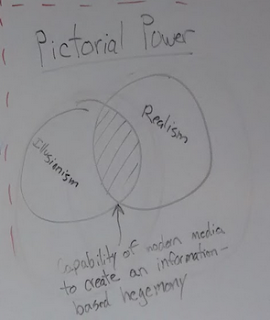Hum and Gates expose the unspoken issues within hegemonic culture, where society is built from certain cultural thoughts and expectations from a dominating cultural group that undermines and excludes other groups to terrible extremes. Hum focuses on an artist from the dominant group in our hegemonic society who has taken the task upon himself to re-present what Gates calls "the Other (be that odd metaphorical negation of the European defined as African, Arabic, Chinese, Latin American, Yiddish, or female)"(2), in Hum's case study, Chinese immigrants. Gates also discusses the author from the dominant group who attempts to re-present "the Other" by creating "pseudoscientific categories"(6). "Western culture's use of writing as a commodity to confine and delimit a culture of color" is exactly how these categories are contrived or, at least, supported (6). Since "reason was privileged, or valorized, above all other human characteristics" and "writing...was taken to be the visible sign of reason", "blacks were 'reasonable,' and hence 'men,' if -- and only if -- they demonstrated mastery of 'the arts and science'" through writing (8). And, unfortunately, "blacks and other people of color could not write" (9). Gates focuses on "the Other" as an author/artist representing their self.
At first thought, these two authors may seem to be in complete different positions: one has the benefit of being a privileged author without the same obstacles keeping him from writing/being published, while the other has the benefit of writing from their own perspective in the actual role of oppression rather than attempting to accurately represent an oppressed individual from the role of a privileged individual. However, both of these authors are faced with a very similar dilemma: reaching marketability. Both the political activist artist in Hum's analysis and the black authors in the Gates' are creating in the hopes of progressing society to recognize Chinese immigrants or black persons as more than just "the Other", the inferior, the slave. In order to reach an audience and possibly achieve these goals, the creators need to focus on their works as something more than just their own opinions: they need create something that can be understood by a larger audience -- and preferably, a powerful audience. This requires that they, as creators, follow the hegemonic societies expectations in order to gain popularity and appeal to the hegemonic groups. Mitchell discusses a similar issue in "Pictures and Power", that the student discussion leader very cleverly turned into a Venn diagram (from the discussion and from Mitchell, 326-328).
Here, Hum's dynamic of authenticity can also replace Mitchell's "illusionism", as it "refers to the depiction not of what is real, but of what a culture perceives as real and true (Gledhill 96)" (Hum 196). These authors who aspire to produce change, must work within this mixture of illusionism and realism to do so. Hum makes this problem very clear in her analysis of Thomas Nast's cartoons of Chinese immigrants. His cartoons attempt to present authentic (dynamic of authentic) characters like the Chinese immigrants and the Irish-European "bullies" in order to produce a dramatized scene that exposes political wrong-doings. In order to follow the dynamic of authenticity, he works with "racialized gaze as design". He stereotypes these characters using imagery associated with them socially, which are often created through illusionism. He solidifies many stereotypes which further alienates "the Other", who is depicted in some of the cartoons as only one person versus a majority group of Irishmen, white men, European/Western men. Nast's images are also harmful, as helpful as he is trying to be, by perpetuating these negative views of both the Eastern immigrants and the Western groups through racialized gaze.
In Gates' case studies, the black author's are pushed into using writing as a tool or method of escape from slavery. If writing is proof of reasoning, and reasoning makes black slaves just as human as white masters, then slaves have a chance to "prove" themselves to white society. "We black people tried to write ourselves out of slavery, a slavery even more profound than mere physical bondage....black writers wrote as if their lives depended upon it"(12-13). In order to do this, black people had to attempt to mimick white literature, criticisms, etc. Therefore, despite seeming to have the agency as their own authors, black people were still forced to right through a racialized gaze. They had to depict themselves in certain ways, that could come across as reasonable to white crowds, that could actually save their lives. Gates' shows this through Rebecca Cox Jackson, who claimed to "hgave been taught to read by the Lord" and she goes so far as to call the Lord "a white man"(13). Because as Hum observes, "the racialized gaze...influences processes such as choice making, even as designers seek to remake and transform their cultural conditions" (Hum 195).

No comments:
Post a Comment
Note: Only a member of this blog may post a comment.